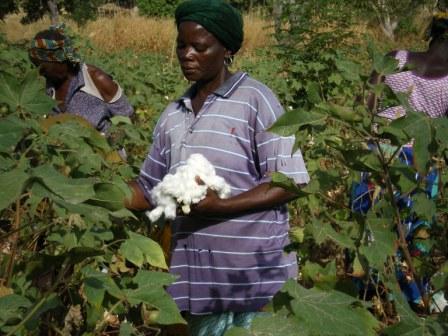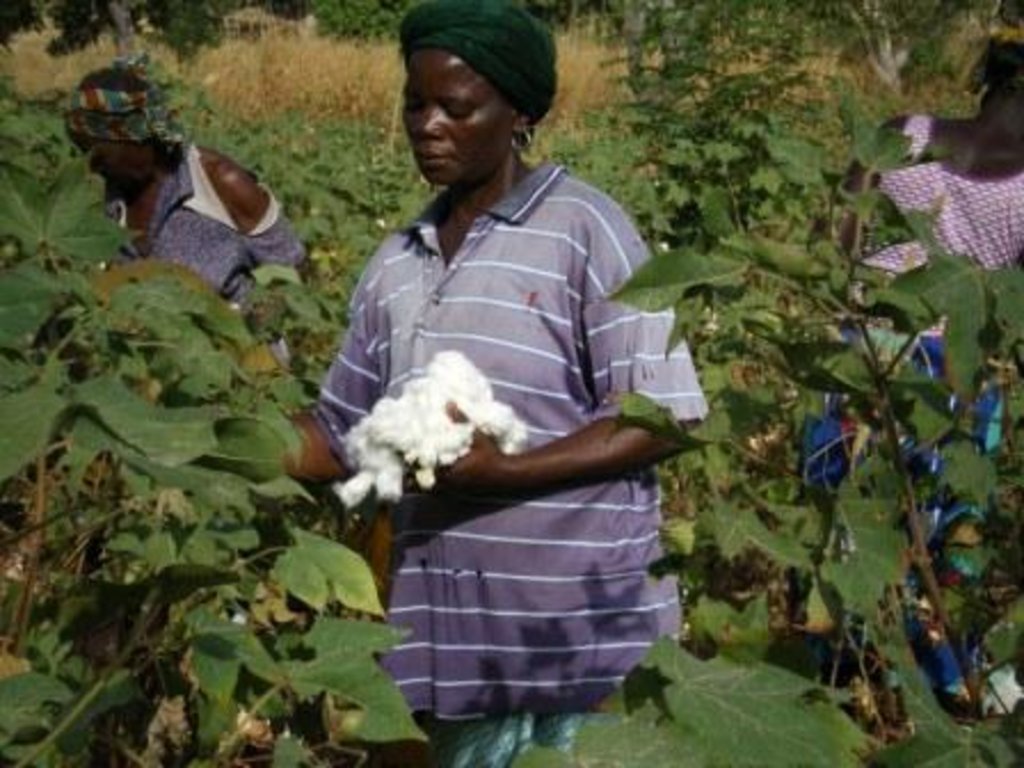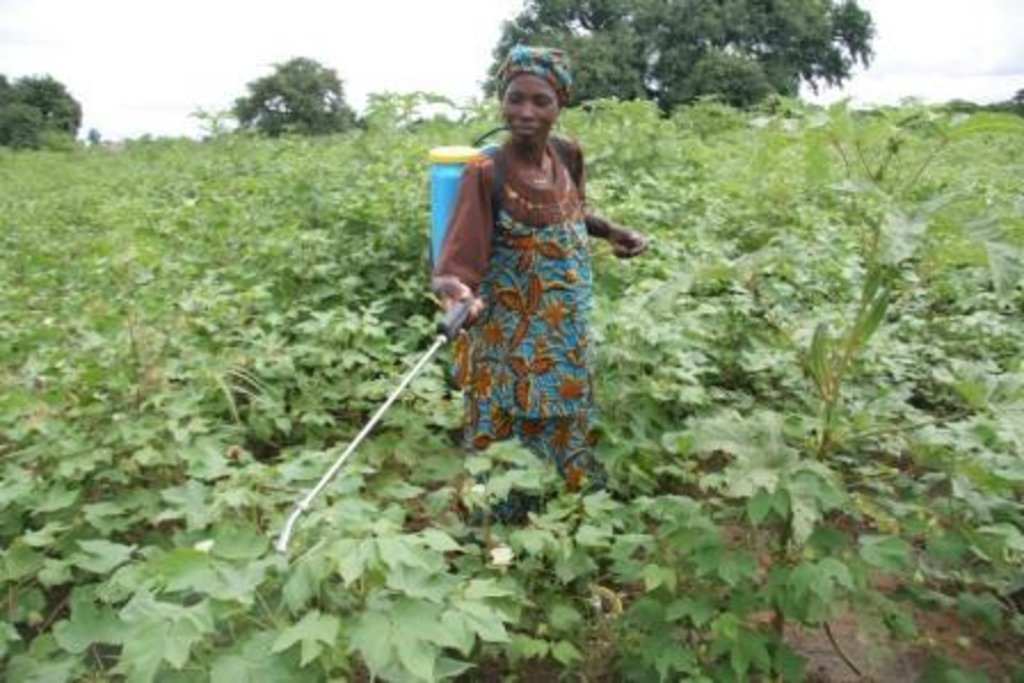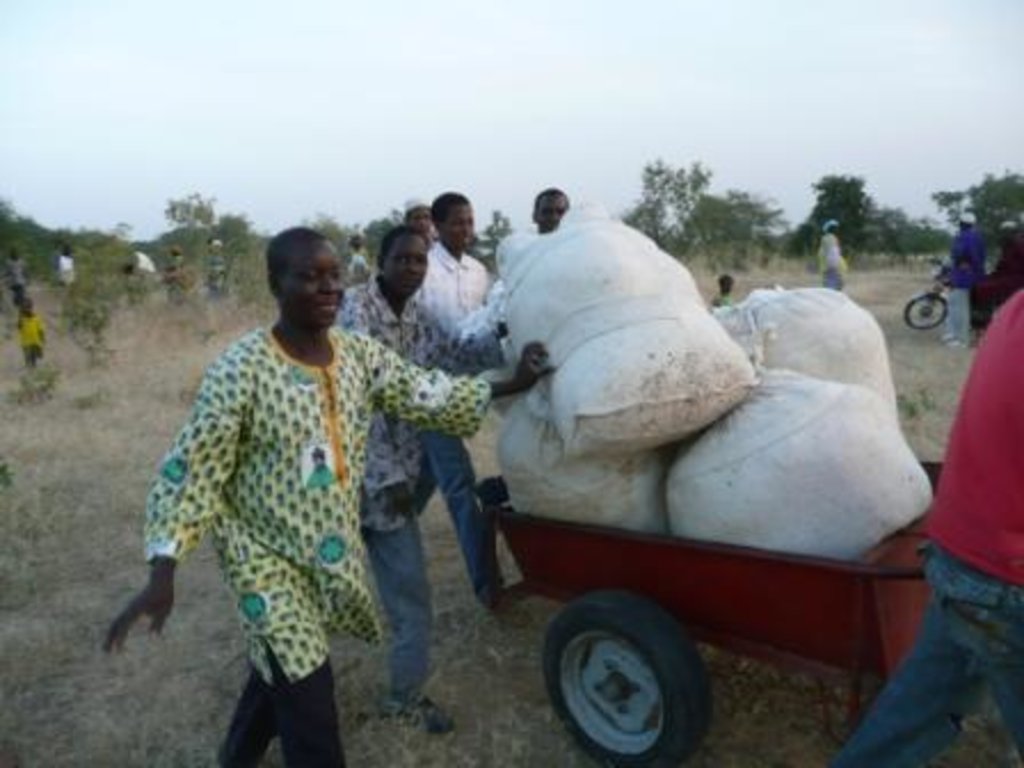Organic cotton [Burkina Faso]
- Creation:
- Update:
- Compiler: Unknown User
- Editor: –
- Reviewers: Fabian Ottiger, Alexandra Gavilano
technologies_957 - Burkina Faso
View sections
Expand all Collapse all1. General information
1.2 Contact details of resource persons and institutions involved in the assessment and documentation of the Technology
Key resource person(s)
SLM specialist:
Lazare Yombi
Helvetas Burkina Faso
Burkina Faso
SLM specialist:
Eyhorn Frank
Helvetas
Burkina Faso
SLM specialist:
Dischl Raphael
Helvetas
Burkina Faso
Name of project which facilitated the documentation/ evaluation of the Technology (if relevant)
Book project: SLM in Practice - Guidelines and Best Practices for Sub-Saharan Africa (SLM in Practice)Name of the institution(s) which facilitated the documentation/ evaluation of the Technology (if relevant)
HELVETAS (Swiss Intercooperation)1.3 Conditions regarding the use of data documented through WOCAT
The compiler and key resource person(s) accept the conditions regarding the use of data documented through WOCAT:
Yes
2. Description of the SLM Technology
2.1 Short description of the Technology
Definition of the Technology:
In the Loba province of Burkina Faso, the production, storage, processing and marketing of organic cotton has been promoted since 2004 by Helvetas.
2.2 Detailed description of the Technology
Description:
Organic cotton production adheres to the principles and standards of organic farming. Any application of synthetic fertilizers and pesticides and the use of genetically modified varieties are forbidden. Organic cotton relies on a combination of different measures: (1) the use of organic fertilizers (manure or compost) and recycling of organic matter; (2) Crop rotation and/or intercropping; (3) Careful selection of varieties adapted to local conditions (climate, soil, pests and diseases); (4) Biological pest management (in combination with careful monitoring of crops); (5) Clear separation of organic and conventional cropland, e.g. by growing border crops (to avoid contact with chemical substances through spray drift or surface runoff); and (6) Soil and water conservation measures. Timely crop management (e.g. weeding) is very important. In Loba rotations crops include sesame (a cash crop), cereals and legumes (food crops), while intercrops include leguminous green manure and trap plants. The best adapted cotton variety is FK-37. Bio-pesticides are produced based on neem seeds (Azadirachta indica). The measures listed above help to improve soil fertility, reduce production costs (and thus financial risk) and avoid the negative effects of conventional farming: declining yields, resistance to pests and diseases, health hazards and environmental problems caused through the use of chemicals. By relying on inputs available/produced on the farm and by getting a better price for certified organic products, profitability of the farm is improved in the long run despite of lower productivity compared to conventional or genetically modified (GM) cotton. Farms need to complete a 3-year conversion period to change their production system from conventional to organic. Farmers have to maintain records and documents for periodic inspection and certification (Internal control system).
2.3 Photos of the Technology
2.5 Country/ region/ locations where the Technology has been applied and which are covered by this assessment
Country:
Burkina Faso
Region/ State/ Province:
Ioba province
Further specification of location:
Dano
Comments:
around 7'000 farmers
2.6 Date of implementation
If precise year is not known, indicate approximate date:
- less than 10 years ago (recently)
2.7 Introduction of the Technology
Specify how the Technology was introduced:
- through projects/ external interventions
3. Classification of the SLM Technology
3.1 Main purpose(s) of the Technology
- conserve ecosystem
- create beneficial economic impact
- create beneficial social impact
3.2 Current land use type(s) where the Technology is applied

Cropland
- Annual cropping
- Perennial (non-woody) cropping
Annual cropping - Specify crops:
- fibre crops - cotton
- legumes and pulses - other
- seed crops - sesame, poppy, mustard, other
Is intercropping practiced?
Yes
Is crop rotation practiced?
Yes
Comments:
Major food crop: Cereals, legumes and root crops for subsistence
Major cash crop: Cotton
Major land use problems (land users’ perception): Fertility decline and reduced OM content; Biodiversity decline
3.4 Water supply
Water supply for the land on which the Technology is applied:
- rainfed
3.5 SLM group to which the Technology belongs
- rotational systems (crop rotation, fallows, shifting cultivation)
- integrated soil fertility management
- Organic production
3.6 SLM measures comprising the Technology

agronomic measures
- A2: Organic matter/ soil fertility
Comments:
Main measures: agronomic measures
Type of agronomic measures: mixed cropping / intercropping, legume inter-planting, manure / compost / residues
3.7 Main types of land degradation addressed by the Technology

chemical soil deterioration
- Cn: fertility decline and reduced organic matter content (not caused by erosion)

biological degradation
- Bs: quality and species composition/ diversity decline
Comments:
Main type of degradation addressed: Cn: fertility decline and reduced organic matter content, Bs: quality and species composition /diversity decline
3.8 Prevention, reduction, or restoration of land degradation
Specify the goal of the Technology with regard to land degradation:
- prevent land degradation
- reduce land degradation
4. Technical specifications, implementation activities, inputs, and costs
4.1 Technical drawing of the Technology
Technical specifications (related to technical drawing):
Technical knowledge required for field staff / advisors: high
Technical knowledge required for land users: moderate
Main technical functions: improvement of ground cover, increase in organic matter, increase in nutrient availability (supply, recycling,…), promotion of vegetation species and varieties (quality, eg palatable fodder)
Secondary technical functions: improvement of water quality, buffering / filtering water
Mixed cropping / intercropping
Material/ species: intercrops include leguminous green manure and trap plants
Manure / compost / residues
Material/ species: manure or compost
Agronomic measure: bio-pesticides
Material/ species: from Neem seeds (Azadirachta indica)
4.3 Establishment activities
| Activity | Timing (season) | |
|---|---|---|
| 1. | Get a knapsack | |
| 2. | None |
4.4 Costs and inputs needed for establishment
| Specify input | Unit | Quantity | Costs per Unit | Total costs per input | % of costs borne by land users | |
|---|---|---|---|---|---|---|
| Labour | Labour | ha | 1.0 | 2.0 | 2.0 | 100.0 |
| Equipment | 15-liter-knapsack | ha | 1.0 | 50.0 | 50.0 | 100.0 |
| Total costs for establishment of the Technology | 52.0 | |||||
| Total costs for establishment of the Technology in USD | 52.0 | |||||
4.5 Maintenance/ recurrent activities
| Activity | Timing/ frequency | |
|---|---|---|
| 1. | Compost production / Clear crop residues on fields where cotton will be planted, use for mulch or compost production (no burning) | |
| 2. | Apply organic manure: 7.5 t/ha / Ploughing (for incorporation of manure, pest and weed control) | |
| 3. | Sow cotton and intercrops (such as Hibiscus esculentus – a trap plant for pests; or Mucuna – a green manure plant); Thin out cotton after 10-20 days (1-2 plants per pocket) | |
| 4. | Weeding (3 to 4 times: 20/40/70/100days after sowing)/ Pest control (manual collection); Spraying of bio-pesticide (64 liters / ha, based on neem seeds): according to infestation: up to 3 times | |
| 5. | Ridging (form furrows and ridges using plough or manually)/ Pre-harvest weeding/ Harvesting/ Cut cotton stems / residues and incorporate into the soil |
4.6 Costs and inputs needed for maintenance/ recurrent activities (per year)
| Specify input | Unit | Quantity | Costs per Unit | Total costs per input | % of costs borne by land users | |
|---|---|---|---|---|---|---|
| Labour | Labour | ha | 1.0 | 160.0 | 160.0 | 100.0 |
| Other | Cotton & intercrop seeds, ma | ha | 1.0 | 28.0 | 28.0 | 100.0 |
| Total costs for maintenance of the Technology | 188.0 | |||||
| Total costs for maintenance of the Technology in USD | 188.0 | |||||
Comments:
Machinery/ tools: hoe, plough, wheel-barrow, knapsack
4.7 Most important factors affecting the costs
Describe the most determinate factors affecting the costs:
Standard equipment (hoe, plough, wheel-barrow) is not included in costs, knapsack is provided by producer’s association (UNPCB) on credit; transport bags are donated. Labour and other inputs for erosion control measures (e.g. stone bunds) are not included in costs. Neem biocide costs US$ 0.7 per liter; organic cotton seeds cost US$ 1.7 per 50 kg.
5. Natural and human environment
5.1 Climate
Annual rainfall
- < 250 mm
- 251-500 mm
- 501-750 mm
- 751-1,000 mm
- 1,001-1,500 mm
- 1,501-2,000 mm
- 2,001-3,000 mm
- 3,001-4,000 mm
- > 4,000 mm
Agro-climatic zone
- semi-arid
Thermal climate class: tropics. Tropical, with high rainfall variability
5.2 Topography
Slopes on average:
- flat (0-2%)
- gentle (3-5%)
- moderate (6-10%)
- rolling (11-15%)
- hilly (16-30%)
- steep (31-60%)
- very steep (>60%)
Landforms:
- plateau/plains
- ridges
- mountain slopes
- hill slopes
- footslopes
- valley floors
Altitudinal zone:
- 0-100 m a.s.l.
- 101-500 m a.s.l.
- 501-1,000 m a.s.l.
- 1,001-1,500 m a.s.l.
- 1,501-2,000 m a.s.l.
- 2,001-2,500 m a.s.l.
- 2,501-3,000 m a.s.l.
- 3,001-4,000 m a.s.l.
- > 4,000 m a.s.l.
Comments and further specifications on topography:
Altitutinal zone: 101-500 m a.s.l. (300-500m)
5.3 Soils
Soil depth on average:
- very shallow (0-20 cm)
- shallow (21-50 cm)
- moderately deep (51-80 cm)
- deep (81-120 cm)
- very deep (> 120 cm)
Soil texture (topsoil):
- coarse/ light (sandy)
- fine/ heavy (clay)
Topsoil organic matter:
- medium (1-3%)
If available, attach full soil description or specify the available information, e.g. soil type, soil PH/ acidity, Cation Exchange Capacity, nitrogen, salinity etc.
Soil texture (topsoil): Coarse/light (sandy or sandy-clayey texture) and fine/heavy (cotton prefers dry, hot and sunny climate, a minimum of 500 mm of rain distributed over the vegetation period (5 months), deep and heavy clay soils (vertisols) with no risk of water-logging)
Soil fertility: Medium
Soil drainage / infiltration: Medium
5.6 Characteristics of land users applying the Technology
Market orientation of production system:
- mixed (subsistence/ commercial)
Individuals or groups:
- individual/ household
Level of mechanization:
- manual work
- animal traction
Indicate other relevant characteristics of the land users:
Difference in the involvement of women and men: certain activities carried out in mutual help groups
Population density: 50-100 persons/km2
Market orientation: Mixed (organic products for market; other crops such as cereals, legumes and root crops for subsistence)
5.7 Average area of land used by land users applying the Technology
- < 0.5 ha
- 0.5-1 ha
- 1-2 ha
- 2-5 ha
- 5-15 ha
- 15-50 ha
- 50-100 ha
- 100-500 ha
- 500-1,000 ha
- 1,000-10,000 ha
- > 10,000 ha
Is this considered small-, medium- or large-scale (referring to local context)?
- small-scale
Comments:
Average cotton production area ca. 1 ha
5.8 Land ownership, land use rights, and water use rights
Land ownership:
- state
Land use rights:
- individual
Comments:
group (family clans) / state
6. Impacts and concluding statements
6.1 On-site impacts the Technology has shown
Socio-economic impacts
Production
risk of production failure
Comments/ specify:
Reduced financial risk, less indebtedness for input provision
Income and costs
farm income
Comments/ specify:
better price due to organic premium (50% more than for conventional cotton) compensates initial decrease of yields
Other socio-economic impacts
Production costs
Comments/ specify:
less expenses for inputs (- 90% compared to conventional cotton), gross margin is 30% higher,
Socio-cultural impacts
health situation
Comments/ specify:
enhanced health of humans and livestock: no health risks due to pesticides, diversified and organic food crops
community institutions
Comments/ specify:
enhanced organisation (farmers groups)
income opportunity for women
Ecological impacts
Soil
nutrient cycling/ recharge
Comments/ specify:
due to organic manure and crop rotation
soil organic matter/ below ground C
Biodiversity: vegetation, animals
beneficial species
Comments/ specify:
Eco-balance between pests and beneficial insects
Other ecological impacts
Soil water holding capacity
Pollution of the environment through toxic chemicals
Comments/ specify:
No pollution
6.3 Exposure and sensitivity of the Technology to gradual climate change and climate-related extremes/ disasters (as perceived by land users)
Comments:
Tolerant to climatic extremes due to higher water retention capacity of soils, reduced erosion and crop diversification (reduced risk of total crop failure)
6.4 Cost-benefit analysis
How do the benefits compare with the establishment costs (from land users’ perspective)?
Short-term returns:
negative
Long-term returns:
slightly positive
How do the benefits compare with the maintenance/ recurrent costs (from land users' perspective)?
Short-term returns:
positive
Long-term returns:
very positive
Comments:
Establishment costs are higher than revenues due to investments & initial decrease in yield (conversion period). On the long term, advanced farmers can achieve same or even higher yields than conventional cotton systems
6.5 Adoption of the Technology
Of all those who have adopted the Technology, how many did so spontaneously, i.e. without receiving any material incentives/ payments?
- 0-10%
Comments:
100% of land user families have adopted the Technology with external material support
Comments on adoption trend: The proportion of organic cotton is growing. Cotton is the top export product in Burkina Faso and other West-African countries (50-60 % of export revenues). The proportion of organic cotton is growing. Actually 1% is produced organically. Around 7,000 farmers are producing organic cotton in Burkina Faso, of whom 28% are women.
6.7 Strengths/ advantages/ opportunities of the Technology
| Strengths/ advantages/ opportunities in the compiler’s or other key resource person’s view |
|---|
| This technology helps to improve soil fertility, reduce production costs (and thus financial risk) and avoid the negative effects of conventional farming: declining yields, resistance to pests and diseases, health hazards and environmental problems caused through the use of chemicals |
6.8 Weaknesses/ disadvantages/ risks of the Technology and ways of overcoming them
| Weaknesses/ disadvantages/ risks in the land user’s view | How can they be overcome? |
|---|---|
| Lack of water | establish water retention structures |
| Weaknesses/ disadvantages/ risks in the compiler’s or other key resource person’s view | How can they be overcome? |
|---|---|
| Coexistence of organic and GMO cotton resulting in high risk of contamination | intensify training of farmers; set up a coordination platform between organic and GMO farms; GMO communication plan; establish a sampling & testing system |
| Insufficient application of manure / compost | training on compost production; promote supply of organic manure (e.g. through SMEs specialized in compost production). |
| Large distance to cotton fields (resulting in high transportation costs) due to interfering of browsing livestock close to village | hay-making and corralling of livestock. |
| Lack of land, land ownership and land security | promote land leasing; resolve tenure problem on political level. |
| Lack of equipment (e.g. plough) | Develop and maintain access to credits for small-scale farmers. |
7. References and links
7.2 References to available publications
Title, author, year, ISBN:
Helvetas. 2008. Guide de production - Un manuel de reference (Authors: Ouedraogo A, Yombi L, Doumbia S, Eyhorn F, Dischl R)
Title, author, year, ISBN:
Eyhorn F., S.G. Ratter, M. Ramakrishnan. 2005. Organic Cotton Crop Guide – A Manual for Practitioners in the Tropics; Research Institute of Organic Agriculture FiBL, Frick, Switzerland
Links and modules
Expand all Collapse allLinks
No links
Modules
No modules





